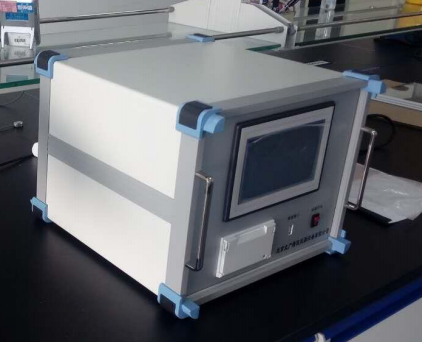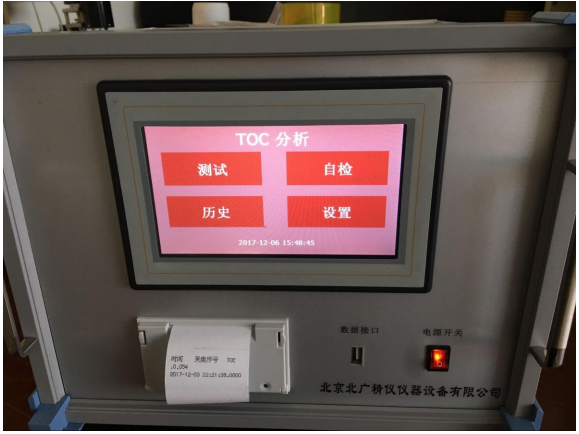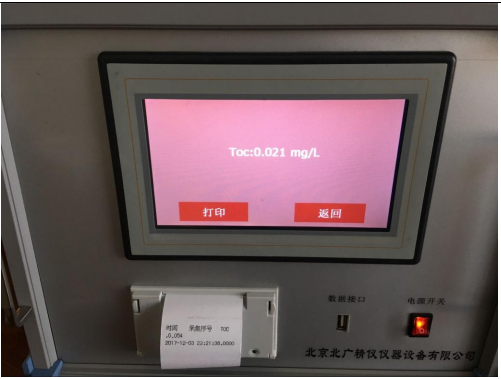
TOC总有碳分析仪厂家 保存历史记录
历史记录的保存对象包括:在线分析结果和离线分析结果。
分析仪有两种存储模式,一种是自动存储;另一种是手动存储。当选择自动存储时,每次测试结束后,仪器会自动保存本次的测试结果。当选择手动存储时,每次开始测试的时候,仪器都会有提示信息,询问用户是否要保存数据。如果要保存测试结果则按“确定”键保存,如果不保存,则按“取消”键放弃保存。
TOC总有碳分析仪厂家 运行要求
交流电源:170~260 V,频率:50/60 Hz;
分析仪的量程是:电导率< 10.0 us/cm;TOC < 1.0 PPM。如果水样中的无机碳或有机碳浓度超出了仪器的检测范围,需使用高纯水或有机碳浓度较低的去离子水冲洗管路。
仪器运行的环境温度5℃ – 40 ℃。
主要特征:
1.高精度、高灵敏度,操作简单。
2.人性化操作界面,有一键运行功能,自动管路清洗功能。
3.高性能CPU,触摸屏设计,超大640*480点阵真彩显示器。
4.不用拆开机箱更换UV灯和泵管。
5.检测上限可设定,自动上限报警功能。
6.具有RS232数据接口,历史数据可存储6个月。
7.离线检测和在线检测可选配。
8.具有打印功能
环境要求
仪器应在一个恒温恒湿且适于工作的环境中进行。避免阳光直射和超常温度;温度过高(超过104?F,40℃)会导致运行失常,温度过低(低于50?F,10℃)会导致测量值误差过大。

使用与操作方法
开始检测并计入检测次数,检测完毕后显示最后一次检测结果,其中几次检测的结果均自动保存在查询记录当中。检测次数的设置方式为:用“选择”键移动光标,用“设置”键修改数字,按“确定”键进行确认,进入分析界面。先进行四次冲洗过程
二氧化碳传感器
仪器上安装有两个二氧化碳传感器,由电导率传感器和温度传感器组成。电导率测量采用双精度技术,可以实现自动校准和温度补偿。TIC传感器用于检测未经氧化的水样中二氧化碳浓度,同时检测水样的电导率值;TC传感器用于检测水样本身含有的二氧化碳和水样中有机物经分解后产生的二氧化碳浓度的总和。
TOC仪器的测定原理
总有机碳(TOC),由专门的仪器——总有机碳分析仪(以下简称TOC分析仪)来测定。TOC分析仪,是将水溶液中的总有机碳氧化为二氧化碳,并且测定其含量。利用二氧化碳与总有机碳之间碳含量的对应关系,从而对水溶液中总有机碳进行定量测定。
仪器按工作原理不同,可分为燃烧氧化—非分散红外吸收法、电导法、气相色谱法等。其中燃烧氧化—非分散红外吸收法只需一次性转化,流程简单、重现性好、灵敏度高,因此这种TOC分析仪广为国内外所采用。

TOC分析仪主要由以下几个部分构成:进样口、无机碳反应器、有机碳氧化反应(或是总碳氧化反应器)、气液分离器、非分光红外CO2分析器、数据处理部分。
技术参数
1.电 源:AC220V?22V
2.电源频率:50Hz?1hz
3.额定功率:100W
4.基本尺寸:44CM?18CM?26CM
5.检测极限:0.001mg/L
6.检测精度:?5%
7.检测范围:0.001mg/L~1.000mg/L
8.分析时间:4min
9.响应时间:15 min以内 within15min
10.样品温度:1-95℃
11.内部样品流速:0.5ml/min
12.相对湿度:≤85%
13.重复性误差:≤3%
14.零点漂移:?5%
15.量程漂移:?5%
16.直 线 性:?5%
适用范围
该仪器用于测试纯水、制药工业去离子水和注射用水的有机碳含量。
制药和生物化学清洗验证:在制药和生物化学制药业处理过程中,监测在循环清洗。半导体中监测纯化水中TOC的含量。

应用范围
A)制药行业注射用水、纯化水
B)半导体工业的超纯水
C)电厂去离子水等
紫外线氧化法
使用UV灯照射待测水样,水会分解成羟基和氢基,羟基和氧化物结合会生成CO2和水,然后检测新生成的CO2即可计算出总有机碳含量。在使用紫外线氧化法时,通过添加二氧化钛,过硫酸盐等可以提高氧化能力。紫外线氧化法的优点是氧化效率高,保养简单,缺点是UV灯管需要定期更换。
Save History
Historical records are saved for online analysis results and offline analysis results.
The analyzer has two storage modes, one is automatic storage; The other is manual storage. When automatic storage is selected, the instrument will automatically save the test results after each test. When manual storage is selected, the instrument will give a prompt every time the test starts, asking the user whether to save the data. If you want to save the test results, press OK to save them. If you do not want to save them, press Cancel to discard the saving.
Operation requirements
AC power supply: 170~260 V, frequency: 50/60 Hz;
The range of the analyzer is: conductivity<10.0 us/cm; TOC < 1.0 PPM。If the inorganic carbon or organic carbon concentration in the water sample exceeds the detection range of the instrument, the pipeline shall be flushed with high-purity water or deionized water with low organic carbon concentration.
The ambient temperature at which the instrument operates is 5 ℃ – 40 ℃.
Main features:
1. High precision, high sensitivity and simple operation.
2. Humanized operation interface, with one button operation function and automatic pipeline cleaning function.
3. High performance CPU, touch screen design, large 640 * 480 dot matrix true color display.
4. Do not disassemble the chassis to replace the UV lamp and pump tube.
5. The detection upper limit can be set, and the automatic upper limit alarm function.
6. With RS232 data interface, historical data can be stored for 6 months.
7. Offline detection and online detection are optional.
8. With printing function
Environmental requirements
The instrument shall be operated in a constant temperature and humidity environment suitable for operation. Avoid direct sunlight and abnormal temperature; Too high temperature (over 104 ? F, 40 ℃) will lead to abnormal operation, and too low temperature (below 50 ? F, 10 ℃) will lead to excessive error of measured value.
Use and operation methods
Start the test and count the test times. After the test, the last test result will be displayed. The results of several tests will be automatically saved in the query record. The setting method of detection times is: move the cursor with the "Select" key, modify the number with the "Set" key, press the "OK" key to confirm, and enter the analysis interface. First, carry out four flushing processes
Carbon dioxide sensor
There are two carbon dioxide sensors installed on the instrument, which are composed of conductivity sensor and temperature sensor. Conductivity measurement adopts double precision technology, which can realize automatic calibration and temperature compensation. The TIC sensor is used to detect the concentration of carbon dioxide in the water sample without oxidation, as well as the conductivity value of the water sample; TC sensor is used to detect the sum of the carbon dioxide contained in the water sample itself and the carbon dioxide concentration generated after the decomposition of organic matters in the water sample.
Measuring principle of TOC instrument
The total organic carbon (TOC) is determined by a special instrument - total organic carbon analyzer (hereinafter referred to as TOC analyzer). TOC analyzer is used to oxidize the total organic carbon in the aqueous solution into carbon dioxide and determine its content. According to the corresponding relationship between carbon dioxide and total organic carbon, the total organic carbon in aqueous solution can be quantitatively determined.
According to different working principles, the instrument can be divided into combustion oxidation non dispersive infrared absorption method, conductivity method, gas chromatography, etc. The combustion oxidation nondispersive infrared absorption method only needs one-time conversion, with simple process, good reproducibility and high sensitivity, so this TOC analyzer is widely used at home and abroad.
TOC analyzer is mainly composed of the following parts: sample inlet, inorganic carbon reactor, organic carbon oxidation reaction (or total carbon oxidation reactor), gas-liquid separator, non dispersive infrared CO2 analyzer, and data processing part.
technical parameter
1. Power supply: AC220V ? 22V
2. Power frequency: 50Hz ? 1hz
3. Rated power: 100W
4. Basic size: 44CM ? 18CM ? 26CM
5. Detection limit: 0.001 mg/L
6. Detection accuracy: ? 5%
7. Detection range: 0.001mg/L~1.000mg/L
8. Analysis time: 4 min
9. Response time: within 15min
10. Sample temperature: 1-95 ℃
11. Internal sample flow rate: 0.5ml/min
12. Relative humidity: ≤ 85%
13. Repeatability error: ≤ 3%
14. Zero drift: ? 5%
15. Range drift: ? 5%
16. Straightness: ? 5%
Scope of application
The instrument is used to test the organic carbon content of pure water, deionized water for pharmaceutical industry and water for injection.
Validation of pharmaceutical and biochemical cleaning: During the processing of pharmaceutical and biochemical pharmaceutical industry, monitor the circulation cleaning. Monitor the content of TOC in purified water in semiconductor.
Scope of application
A) Water for injection and purified water in pharmaceutical industry
B) Ultrapure water in semiconductor industry
C) Power plant deionized water, etc
Ultraviolet oxidation
When the UV lamp is used to irradiate the water sample to be tested, the water will be decomposed into hydroxyl and hydrogen groups. The combination of hydroxyl and oxide will generate CO2 and water, and then the newly generated CO2 can be detected to calculate the total organic carbon content. When using the ultraviolet oxidation method, the oxidation capacity can be improved by adding titanium dioxide, persulfate, etc. The advantages of UV oxidation method are high oxidation efficiency and simple maintenance, while the disadvantages are that UV lamps need to be replaced regularly.
业务咨询:932174181 媒体合作:2279387437 24小时服务热线:15136468001 盘古机械网 - 全面、科学的机械行业免费发布信息网站 Copyright 2017 PGJXO.COM 豫ICP备12019803号